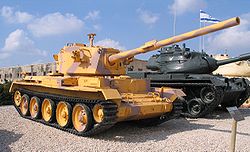
Ordnance QF 20 pounder
Encyclopedia

Tank gun
A tank gun is the main armament of a tank. Modern tank guns are large-caliber high-velocity guns, capable of firing kinetic energy penetrators, high explosive anti-tank rounds, and in some cases guided missiles. Anti-aircraft guns can also be mounted to tanks.-Overview:Tank guns are a specific...
introduced in 1948 and used in the Centurion tank
Centurion tank
The Centurion, introduced in 1945, was the primary British main battle tank of the post-World War II period. It was a successful tank design, with upgrades, for many decades...
and the Charioteer tank destroyer
Charioteer tank destroyer
The Charioteer tank destroyer officially known as FV4101 Cromwell Heavy AT Gun was a British tank destroyer, designed in the 1950s from the Cromwell tank and used to add firepower to units serving in West Germany.-Development:...
. It was the improved successor to the effective Ordnance QF 17 pounder
Ordnance QF 17 pounder
The Ordnance Quick-Firing 17 pounder was a 76.2 mm gun developed by the United Kingdom during World War II. It was used as an anti-tank gun on its own carriage, as well as equipping a number of British tanks. It was the most effective Allied anti-tank gun of the war...
and the predecessor of the 105 mm L7 gun
Royal Ordnance L7
The Royal Ordnance L7 is the basic model of Britain's most successful tank gun. The L7 was a 105 mm L/52 rifled design intended for use in armoured fighting vehicles...
.
Design and development
The 20 pounder's design followed that of the German 8.8 cm KwK 43, a cannon used in the Second World War King TigerTiger II
Tiger II is the common name of a German heavy tank of the Second World War. The final official German designation was Panzerkampfwagen Tiger Ausf. B,Panzerkampfwagen – abbr: Pz. or Pz.Kfw. Ausführung – abbr: Ausf. .The full titles Panzerkampfwagen Tiger Ausf...
tank. Like the KwK 43, the 20 pounder had a length of 66.7 calibres and could fire both APCBC
APCBC
The armour-piercing capped ballistic cap is a type of armor-piercing shell introduced in the 1930s.-Development:The APCBC munition type was an evolutionary development of the early war armour-piercing capped shell, itself an evolution of the more basic AP and APHE shell types...
and sub-calibre rounds. The 20 pounder's APCBC projectile had a muzzle velocity
Muzzle velocity
Muzzle velocity is the speed a projectile has at the moment it leaves the muzzle of the gun. Muzzle velocities range from approximately to in black powder muskets , to more than in modern rifles with high-performance cartridges such as the .220 Swift and .204 Ruger, all the way to for tank guns...
of 1,020 meters per second and could penetrate 21 cm of rolled homogeneous armour
Rolled homogeneous armour
Rolled homogeneous armour is a type of steel which is used to armour vehicles.-Composition:Armoured steel must be hard yet impervious to shock in order to resist high velocity metal projectiles. Steel with these characteristics is produced by processing cast steel billets of appropriate size and...
(RHA) while the APDS
APDS
APDS may refer to:*Armour-piercing discarding sabot*Androgynous Peripheral Docking System*Augusta Preparatory Day School...
projectile had a muzzle velocity of 1465 m/s (4,806.4 ft/s) and could penetrate 30 cm (11.8 in) of RHA. The 20-pounder could also fire high-explosive and canister shot
Canister shot
Canister shot is a kind of anti-personnel ammunition used in cannons. It was similar to the naval grapeshot, but fired smaller and more numerous balls, which did not have to punch through the wooden hull of a ship...
.
The L7 105 mm tank gun was developed in 1954 from the 20 pounder by re-boring the tube.
The gun was fitted to the Swiss pre-production Panzer 58
Panzer 61
The Panzer 61 was a Swiss Cold War era medium tank. The tank had a weight of 36.5 tons and was powered by a 630hp diesel engine which gave it a top road speed of 31 mph...
.
Performance
| Weapon | Muzzle Velocity metres/second |
Penetration mm |
|---|---|---|
| 20-Pounder (firing M3 APDS) | 1,465 | 287 (at 90°, range 1,000 metres) |
| 85 mm D-48 (firing BR-372) | 1,040 | 185 (at 90°, range 1,000 metres) |
| 8.8 cm PaK 43 (firing PzGr 40/43) | 1,130 | 193 (at 60°, range 1,000 metres) |
| 90 mm M3 (firing M304) | > 195 (at 60°, range 914 metres) | |
| These data are not directly comparable as various measurement methods are used. They are, however, illustrative of the relative performance of the weapons. |
||

